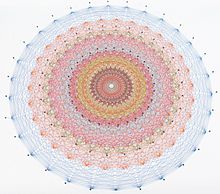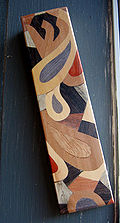- String art
-
 A string art representing a projection of the 8-dimensional 421 polytope
A string art representing a projection of the 8-dimensional 421 polytope
String art, or pin and thread art, is characterized by an arrangement of colored thread strung between points to form abstract geometric patterns or representational designs such as a ship's sails, sometimes with other artist material comprising the remainder of the work. Thread, wire, or string is wound around a grid of nails hammered into a velvet-covered wooden board. Though straight lines are formed by the string, the slightly different angles and metric positions at which strings intersect may give the appearance of Bézier curves (and often construct actual quadratic Bézier curves). Other forms of string art include Spirelli, which is used for cardmaking and scrapbooking, and curve stitching, in which string is stitched through holes.
String art has its origins in the 'curve stitch' activities invented by Mary Everest Boole at the end of the 19th Century to make mathematical ideas more accessible to children.[1] It was popularised as a decorative craft in the late 1960s through kits and books.[citation needed]
References
Bibliography
- Lois Kreischer (1971). Symmography. Crown Publishers, New York, NY. ISBN 0517502747
- Robert Sharpton (1972). Designing In String. Cunningham Art Products, Inc. No ISBN.
- Mark Jansen, Ric Barline, Fred Fortune (1972). The Art of Geometric Thread Design. Open Door Company, Campbell, CA. No ISBN.
- Brian and Patricia Eales (1973). Pin and Thread. Flarepath Printers Ltd., Great Britain. No ISBN.
- Glen D. Saeger (1973). String Things You Can Make. Sterling Publishing Co., New York, NY. ISBN 0806952628
- Glen D. Saeger (1973). String Designs. Sterling Publishing Co., New York, NY. ISBN 0806953209
- Vivian Bowler (1974). 44 String and Nail Art Projects. Crown Publishers, New York, NY. No ISBN.
- James E. Gick (1974). Thread Design. Hazel Pearson Crafts, Rosemead, CA. No ISBN.
- Douglas K. Dix (1975). Filography. Pan Books Ltd., London. ISBN 0330241559
- Robert Sharpton (1975). String Art: Step-By-Step. Chilton Book Co. Radnor, PA. ISBN 0801961319
- Marie-Claude Riviere (1975). Pin Pictures With Wire and Thread. Sterling Publishing Co., New York, NY. ISBN ?
- Fran Risting (1975). String Art. Drake Publishing, NY and London. ISBN 0877498164
- Unknown Author (1975). String Art Made Easy. Clapper Publications Co. Ridge Park, Illinois. No ISBN.
- Compilation (1976). String Art Encyclopedia. Sterling Publishing Co., New York, NY. ISBN 0806953624
- Richard Ohanian (1976). The Family Creative Workshop. Plenary Publications International, New York, NY. ISBN 0884590178
- Warren Farnworth (1977). Techniques and Designs in Pin and Thread Craft. BT Batsford Ltd., London. ISBN 071340535
- Roland and Dominique Cauro (1978). Stringcraft. Sterling Publishing Co., New York, NY. ISBN 0806953640
- Raymond Gautard (1978). The Beautiful String Art Book. Sterling Publishing Co., New York, NY. ISBN 0806953861
- Jane Hermsen (2003). Spirelli. Forte Publishers BV, The Netherlands. ISBN 9058772713
External links
- Psychedelic.fm 'How to: String Art'
- string art at Math Cats
- http://www.teachersnetwork.org/dcs/math/stringart/index.html
- curve-stitch Designs
- David Chow design
- String art master works
- Agota's Stringart World with 600 patterns
- http://www.bloggen.be/strings_and_things
- http://www.stringmandalas.com/index.html
- String art in Spain. EMAGU's Collection
Categories:- Art media
- Mathematics and culture
Wikimedia Foundation. 2010.


